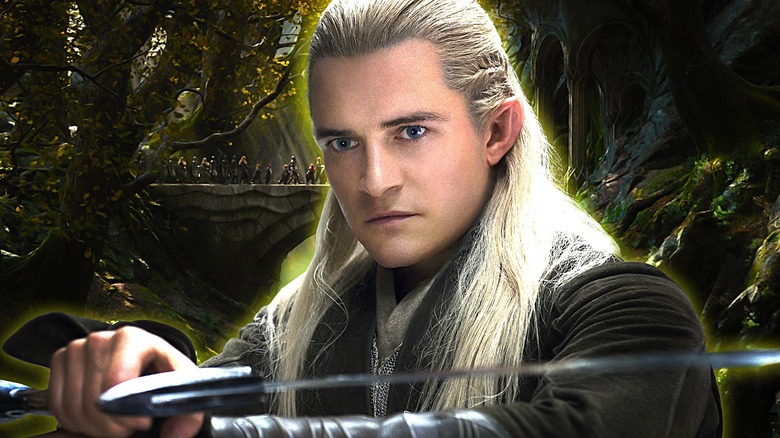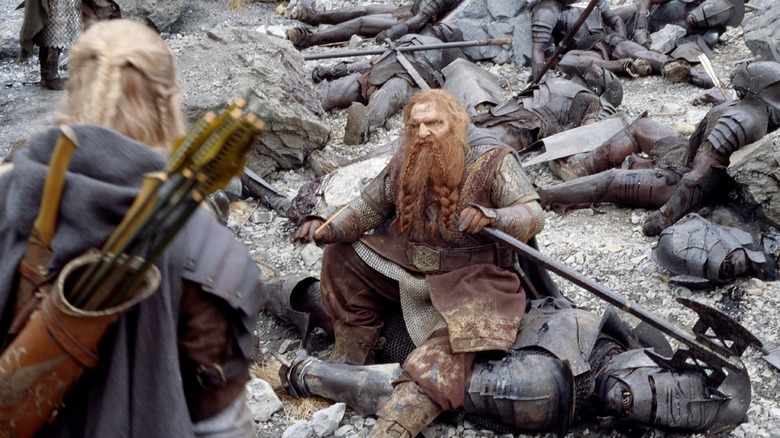
Legolas is an important Elf in J.R.R. Tolkien’s stories. The Elven Prince of Mirkwood functions as a messenger, a counselor, and a friend. (He also really does talk to Frodo — just for the record.) However, his most famous role is as a light-footed warrior with deadly combat skills, both at a distance and in hand-to-hand combat. He appears in five of the six Peter Jackson Middle-earth movies. Over those films, the Elven archer amasses a total kill count of 177 — a significant portion of the total “Lord of the Rings” death count. The number comes from a compilation clip on the YouTube channel Auralnauts.
The nearly 10-minute-long video has a retro video game theme and methodically works through every instance where Legolas dispatches an enemy on-screen. The kills are presented in release order, so we see his violent action-hero antics in the Hobbit franchise (which occurs before “The Lord of the Rings” in-universe) in the second half of the video.
The final count is 177, including a few estimates of mass-killing moments. The number also includes a reduction of 13 as a “sore loser debuff” attributed to Gimli’s gaming complaints about how to count the Oliphaunt during the Battle of the Pelennor Fields. If you were to add those kills back in, it would put Legolas’ on-screen life-taking total at 190. Throughout the action, we see Legolas dispatch orcs, goblins, Uruk-hai, men, trolls (yes, plural), spiders, and wargs. The final “boss mode” kill to rule them all comes against Bolg in “The Hobbit: The Battle of the Five Armies.”

Legolas’ kill count is larger in the movies than it is in J.R.R. Tolkien’s writings for a couple of reasons. First, the Elven princeling is in the Hobbit films, but he isn’t named in the book. Second, Tolkien doesn’t go into much detail about individual kills, with one exception, and it happens to be the inspiration for all of this kill-counting obsession.
In the “Two Towers” book, during the Battle of Helm’s Deep, Legolas and Gimli engage in a back-and-forth contest to see who can kill more enemies. It starts when Gimli kills two enemies, only for Legolas to say, “I have done better, though now I must grope for spent arrows; all mine are gone. Yet I make my tale twenty at the least. But that is only a few leaves in a forest.” When Gimli reports that he’s reached 21 kills, Legolas updates that he’s reached 24, thanks to his knives. When the friends reunite after the battle, Gimli announces that he dispatched 42 foes, to which Legolas responds that he killed 41, though he doesn’t grudge Gimli his win. He’s just happy to see him alive.
Peter Jackson and Co. channeled this friendly battlefield competitiveness into “The Two Towers,” which was fun. However, they amped up the competition in “The Return of the King,” where Legolas takes down an entire Oliphaunt single-handed. In the Hobbit films, the Elven warrior’s eye for striking a killer blow escalated to new heights, as he wipes out dozens of foes, sometimes in a matter of seconds. It may not reflect the original, low-key aspect of the friendly challenge, but it sure does lead to a high kill count for one of the Fellowship of the Ring’s most powerful characters.
In the “Two Towers” book, during the Battle of Helm’s Deep, Legolas and Gimli engage in a back-and-forth contest to see who can kill more enemies. It starts when Gimli kills two enemies, only for Legolas to say, “I have done better, though now I must grope for spent arrows; all mine are gone. Yet I make my tale twenty at the least. But that is only a few leaves in a forest.” When Gimli reports that he’s reached 21 kills, Legolas updates that he’s reached 24, thanks to his knives. When the friends reunite after the battle, Gimli announces that he dispatched 42 foes, to which Legolas responds that he killed 41, though he doesn’t grudge Gimli his win. He’s just happy to see him alive.
Peter Jackson and Co. channeled this friendly battlefield competitiveness into “The Two Towers,” which was fun. However, they amped up the competition in “The Return of the King,” where Legolas takes down an entire Oliphaunt single-handed. In the Hobbit films, the Elven warrior’s eye for striking a killer blow escalated to new heights, as he wipes out dozens of foes, sometimes in a matter of seconds. It may not reflect the original, low-key aspect of the friendly challenge, but it sure does lead to a high kill count for one of the Fellowship of the Ring’s most powerful characters.


